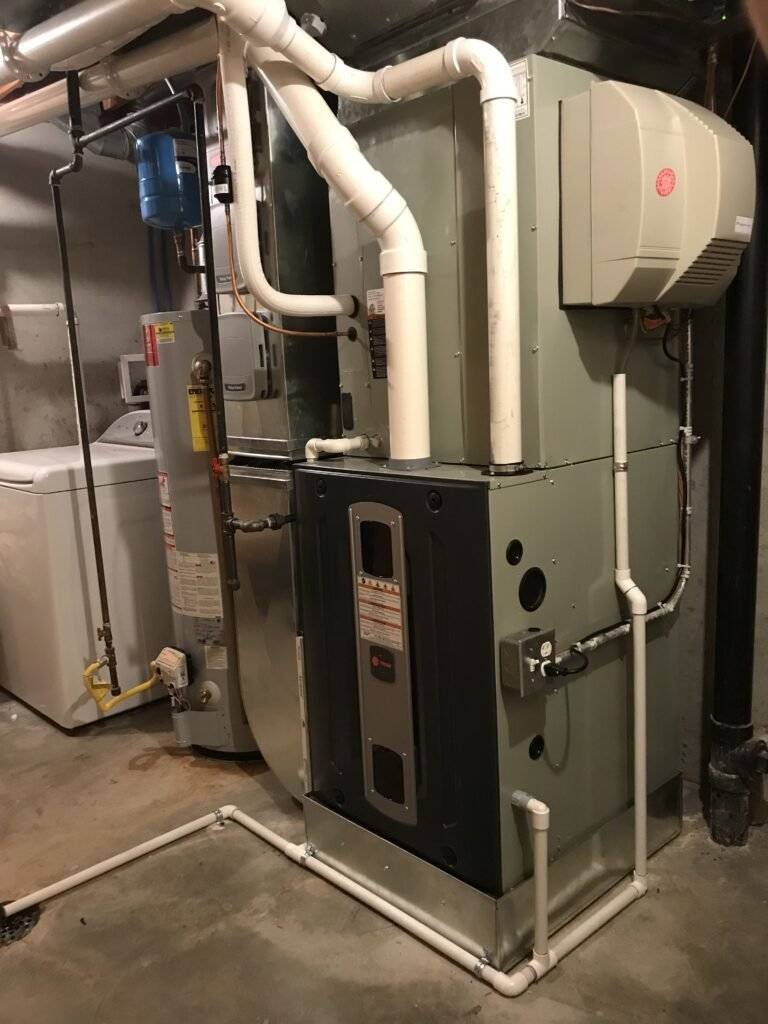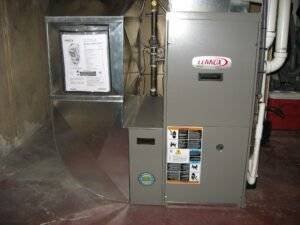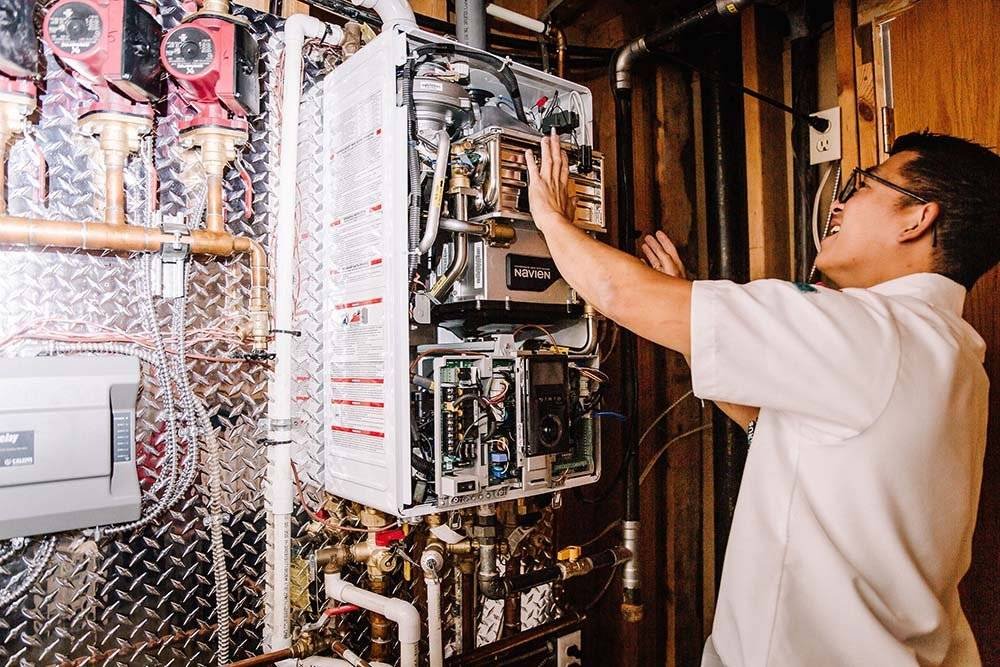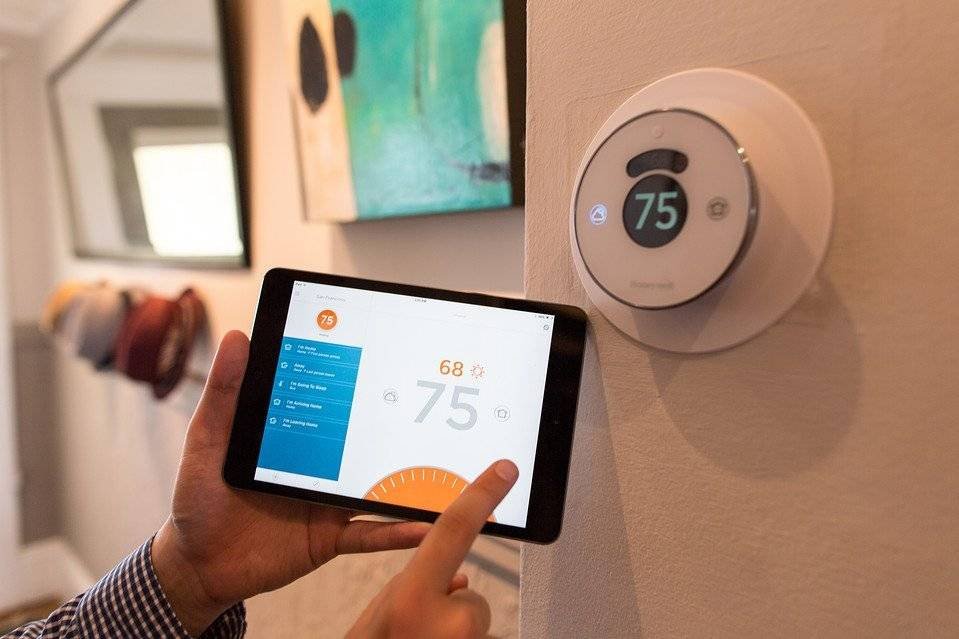Furnace Installation Calmar - Your Reliable Heating Specialists
Furnace Pros Plus is your dependable partner for all your heating needs. With years of experience, we specialize in providing top-notch heating solutions to keep your home warm and comfy. Our team of experienced professionals commit themselves to providing expert furnace setup, upkeep, and repair services. We comprehend the value of a properly functioning heating system, particularly throughout the cooler months. We prioritize effectiveness, cost, and client fulfillment in every project (big or small). Whether you need a brand-new furnace, a regular check-up, or emergency repairs, count on Furnace Pros Plus for reputable and efficient heating services that guarantee peace of mind and convenience.


Who Are We?
Domestic Furnace Replacements and Repairs
Furnace Pros Plus stands apart as the top furnace installation and repair business in Strathcona, Alberta, thanks to its unrivaled devotion to quality, customer service, and expertise. With years of experience in the heating and cooling industry, Furnace Pros Plus has built a reputation for providing dependable and efficient services tailored to the special environment and needs of Strathcona residents.
The company’s dedication to excellence begins with its team of licensed specialists. Each technician is not just extremely skilled and knowledgeable about the latest furnace technology but also dedicated to continuous training and advancement. This guarantees that every setup or repair is performed with the utmost accuracy and current methods, ensuring superior efficiency and durability of your heating system.
Furnace Pros Plus comprehends the value of a well-functioning furnace, particularly throughout the severe Strathcona winter seasons. That’s why they offer a rapid response to guarantee that any furnace emergency is handled immediately and effectively, reducing inconvenience and possible hazards. Their 24/7 availability is a testimony to their devotion to client fulfillment and safety.
Furthermore, Furnace Pros Plus makes use of just the highest quality products and products in all their installations and repairs. By partnering with leading manufacturers, they guarantee that every element of your heating system is durable and efficient, providing optimum heating and reducing energy costs. This dedication to quality, extends the life of the furnace, providing more worth for the investment.
In addition to their technical expertise, Furnace Pros Plus excels in customer service. They prioritize clear communication, providing in-depth consultations and transparent rates without surprise fees. Their personalized method implies that every service is tailored to the specific needs and budget of their clients, guaranteeing that you feel valued and pleased with every interaction.
For these reasons and more, Furnace Pros Plus is the top option for anybody requiring furnace setup and repair services in Strathcona, demonstrating an unbeatable mix of quality, expertise, and customer-focused service.
How can we help you?

Understanding the Cost of Installing a Modern Furnace
Intro
A working furnace is necessary when it pertains to preserving a comfortable and warm home throughout the cooler months. However, there comes a time when installing a brand-new furnace is unavoidable.
Understanding the costs associated with this process is essential for homeowners to plan and budget accordingly. This comprehensive guide checks out the various aspects influencing the expense of installing a brand-new furnace.
Aspects Affecting Heating System Installation Costs
Type of Heater:
- Gas Heaters: Popular for their effectiveness, they generally cost more in advance but offer lower operating expense.
- Electric Furnaces: They are more economical than gas furnaces. However, electric designs tend to have higher operational costs due to electrical power costs.
- Oil Heating systems: These are less typical and can be more costly due to the expense of oil.
Heating System Size and Capability
- Square Footage: The size of your home directly impacts the capacity required for the furnace.
- BTU Rating: Higher BTU rankings correspond to more effective furnaces, which can increase the expense.
Performance Rankings
Annual Fuel Usage Performance (AFUE):
Higher AFUE rankings indicate better effectiveness but also included a greater price.
Brand and Quality
Top-tier brand names frequently command higher costs due to their reputation for quality and durability.
Installation Intricacy
- Existing System: Updating from an old system might need extra work and expense.
- Ductwork: The condition and layout of existing ductwork can impact setup complexity.
- Availability: Challenging access to the setup website can increase labour costs.
Labour Costs
Labour costs vary by area. In addition, the complexity of the setup can influence labour costs.
Additional Costs to Consider
- Permits: Some areas need authorizations for furnace setup.
- Inspections: City laws might need post-installation examinations for safety compliance.
- Thermostats: Updating to a wise thermostat can sustain extra costs.
Average Cost of Heating System Replacement
While costs can vary commonly based upon the aspects mentioned above, here are some typical expense ranges for furnace setup:
- Gas Heating systems: $2,000 to $5,000.
- Electric Furnaces: $1,000 to $2,500.
- Oil Heating systems: $2,500 to $6,000.
These are rough quotes and can vary based upon specific home requirements.
Cost-Saving Tips.
Research study and Compare.
Obtain multiple quotes from different contractors to guarantee competitive rates.
Look For Refunds and Rewards.
Look for energy effectiveness refunds offered by energy business or government programs.
Consider Long-Term Savings.
Buying a more efficient furnace can lower energy costs over time.
Conclusion
Setting up a brand-new furnace is a considerable investment, and comprehending the costs involved is necessary for any homeowner. By considering the kind of furnace, setup complexity, labour costs, and extra costs, homeowners can better get ready for this necessary upgrade. Keep in mind to seek multiple quotes, explore readily available refunds, and think about long-term energy savings when deciding.

The Right Dimension Heating System for Your Home: A Comprehensive Guide
Intro
Picking the ideal size furnace for your home is essential for guaranteeing efficient heating and convenience throughout the cooler months. A heater that’s too small will not keep your house warm, while one that’s too big can cause unnecessary energy consumption and unequal heating. This guide will help you figure out the ideal furnace size for your home.
Understanding Heating System Sizing: BTU and Performance
We determine the size of a heater in British Thermal Units (BTU). One BTU is the energy required to raise the temperature of one pound of water by one degree Fahrenheit. When choosing a heater, 2 key aspects contribute: the BTU score, indicating the furnace’s heating capacity, and its effectiveness score, measured in Annual Fuel Usage Performance (AFUE).
Calculating Your Home’s Heating Needs
You must calculate your home’s heating needs to figure out the proper furnace size. The computation thinks about aspects like square video, environment zone, insulation quality, window type, and house layout. Usually, you need approximately 30-60 BTUs per square foot. However, this varies based upon your home’s specific characteristics.
Climate Zone and Its Effect On Heating System Size
Your geographical place significantly influences the furnace size required. Houses in cooler areas, such as [place], need more BTUs per square foot than those in milder environments. Seek advice from a heating professional for specific suggestions.
The Function of Home Insulation in Heating System Sizing
Excellent insulation reduces the quantity of heat loss, meaning you can go with a smaller furnace. Examine your home’s insulation in the walls, attic, and windows. Updating insulation can be a cost-efficient way to minimize heating needs.
Considerations for Different Kinds Of Heaters
There are various types of furnaces, like gas, electric, and oil. Each type has special sizing considerations. Gas furnaces are common and efficient, electric furnaces are more uncomplicated and much safer but frequently more costly to operate, and contractors set up oil furnaces where gas isn’t readily available.
Importance of Professional A/c Assessment
An expert HVAC assessment is important. Professionals think about all variables, including ductwork and home layout, to recommend the optimum furnace size. They can carry out a Manual J computation, the industry standard for determining heating and cooling loads.
Energy Performance and Cost-Effectiveness
Picking a heater with a high AFUE score is essential for energy effectiveness and expense savings. Modern furnaces have AFUE rankings between 80% and 98%, indicating the percentage of fuel converted into heating. While high-efficiency furnaces are more costly in advance, they can result in significant savings in the long run.
Dealing With Typical Misconceptions About Heating System Sizing
A typical misconception is that a larger furnace is always better. However, an oversized furnace can result in short cycling, where the furnace often turns on and off, reducing effectiveness and life expectancy. Alternatively, an undersized furnace struggles to warm your home sufficiently.
Long-Term Advantages of the Right-Sized Heater
Picking the right-sized furnace has long-term advantages, including consistent convenience, lower energy costs, reduced carbon footprint, and fewer upkeep issues. It’s a balance between in advance costs and long-term savings.
Summary: Making an Educated Decision
Picking the ideal size furnace is a choice that impacts your home’s convenience and energy effectiveness for several years to come. By comprehending the basics of furnace sizing and seeking expert guidance, you can make an informed choice that guarantees optimum heating for your home.
Keep in mind, the key to an efficient and comfy home lies in choosing the ideal furnace and regular upkeep and considering other aspects like insulation and environment. With this comprehensive guide, you are fully equipped to pick the best furnace for your home, providing warmth and convenience for numerous winter seasons.

Replace vs Repair Heating System: A Full Guide
Intro
Deciding whether to replace or fix your furnace is a considerable choice for any homeowner. The option impacts your immediate convenience and safety and has long-term monetary implications. This comprehensive guide will explore various elements to think about, assisting you make a notified choice.
Understanding Your Heater
Life expectancy and Types
Heating systems generally have a life expectancy of 15-20 years. The two primary types are gas and electric, each with different upkeep and operational costs.
Signs of Trouble
Typical indications that your furnace might need attention include unusual sounds, inconsistent heating, and increased energy costs.
When to Consider Fixing Your Heating System
Repair is frequently the best option for minor issues or furnaces that are reasonably new and still under warranty.
Cost-Effectiveness
Fixing can be more economical for minor issues. However, regular repairs may show a deeper issue.
Ecological Impact
Repairs frequently have a lower environmental effect than replacing the entire system.
When Replacement is the Very Best Option
You need to think about replacement if your furnace is near the end of its life expectancy, repairs are becoming significantly costly, or if it could be more energy efficient.
Long-term Cost Savings
While the preliminary expense is higher, a brand-new furnace can be more energy-efficient, saving you cash on energy costs.
Technological Improvements
More recent designs come with innovative innovation, such as clever thermostats, which offer better temperature level control and effectiveness.
Weighing Your Choices
Cost Analysis
Compare the expense of repairs over time versus the one-time expenditure of a brand-new furnace.
Energy Performance
Examine how your present furnace’s effectiveness is impacting your energy costs.
Home Worth
Think about how a brand-new furnace may increase the worth of your home, particularly if you plan to offer in the future.
Professional Suggestions
Looking For Expert Opinion
Talk to HVAC specialists to evaluate the state of your present furnace and get quotes for repair and replacement.
Importance of Routine Maintenance
Routine upkeep can extend the life of your furnace, whether you decide to fix or replace it.
Summary
In conclusion, deciding to fix or replace your furnace depends on various aspects, including age, condition, expense, and energy effectiveness. By considering these aspects and seeking expert guidance, you can decide that guarantees convenience, safety, and monetary vigilance for your home.

What Time of Year is the Least Expensive to Replace The Heating System?
Will a Modern Heating System Lower Your Residence Insurance Coverage?
Intro
Home upkeep can be a considerable investment, particularly when it involves essential systems like heating. One of the most considerable costs homeowners deal with is replacing their furnace. However, timing this replacement can result in significant savings. This short article checks out the best season to replace your furnace, considering cost-effectiveness and usefulness.
Understanding Heating System Replacements
The Requirement for Replacement
Before diving into timing, it’s necessary to comprehend why and when you need to replace your furnace. Typical signs include regular repairs, heating inefficiency, and the system’s age (typically beyond 15-20 years). Changing an out-of-date or malfunctioning furnace improves heating effectiveness and guarantees safety and convenience throughout cooler months.
Aspects Affecting Heating System Costs
Numerous aspects impact furnace costs, including the kind of furnace, brand, capacity, and the complexity of setup. Seasonal need is another significant element, frequently overlooked, yet it plays a vital role in determining the expense.
Finest Time for Replacement: Off-Season
Why Select Off-Season?
The off-season, mostly spring and early fall, is generally the cheapest to replace a heater. The need for heating unit is lower throughout these periods than throughout the peak cold weather. Lower need frequently leads to more competitive rates from manufacturers and installers.
Benefits of Off-Season Replacement
- Lower Costs: Decreased need can result in discount rates and more customer negotiating power.
- Schedule of Technicians: HVAC professionals are less busy throughout these times, guaranteeing more flexible scheduling and quicker setup.
- Ample Time for Research study: The off-season offers homeowners adequate time to research study different furnace designs and options without the pressure of immediate need.
Preparation Ahead
Making use of the off-season requires preparation. Prepare for the need for replacement and schedule it when the need is low. This foresight saves cash and avoids the trouble of a heater breaking down in the middle of winter season.
Winter: The Peak Season
Difficulties of Winter Replacement
- Higher Costs: The need for furnace setup and repair peaks throughout winter season, resulting in higher costs.
- Hectic Schedules: Discovering a technician might be more tough, and you may have to wait longer for a visit.
- Emergency Replacements: If your furnace breaks down in winter season, you may have to go with an instant replacement, which leaves little space for expense contrast or settlement.
Other Factors to consider
Energy Performance and Rebates
Buying energy-efficient designs might be more costly in advance but can result in long-term savings. Also, look out for refunds and tax credits offered for energy-efficient home improvements.
Importance of Routine Maintenance
Routine upkeep can prolong the life of your furnace, postponing the need for replacement. It’s an essential element of home care that you need to take note of.
Summary
Timing your furnace replacement can result in significant savings. The off-season, especially spring and early fall, is generally the most economical duration for this investment. Preparation, considering energy effectiveness, and preserving your present furnace can optimize costs and guarantee a warm, comfy home.
Intro
Property owners frequently ponder whether updating their home devices and systems can result in savings on their home insurance coverage premiums. One typical concern is whether installing a brand-new furnace lowers home insurance coverage costs. This short article delves into how a brand-new furnace setup may affect your home insurance coverage, using insights into insurance policies, risk management, and possible savings.
Understanding Residence Insurance Coverage Premiums
Before diving into the specifics of furnaces and insurance coverage, it’s essential to comprehend what aspects influence home insurance coverage premiums. Insurance companies evaluate various aspects, including:
- Home Age and Condition: Insurance Representatives view more recent homes with upgraded systems as lower risks.
- Area: Geographical place and regional environment can significantly impact insurance coverage rates.
- Safety Features: The presence of alarms, smoke detectors, and other safety gadgets can lower premiums.
The Impact of a New Heating System on Residence Insurance Coverage
Setting up a brand-new furnace in your home can have a number of implications for your home insurance coverage:
- Decreased Threat of Fire and Gas Leaks: Modern furnaces with innovative safety functions lessen risks like fire or gas leaks. This risk decrease can be beneficial in the eyes of insurance coverage companies.
- Improved Energy Performance: Newer furnaces are frequently more energy-efficient, resulting in lower energy costs and a minimized environmental footprint, indirectly affecting insurance coverage considerations.
- Boosted Home Worth: Updating to a brand-new furnace can increase your home’s market value, which may impact the coverage you need.
Potential Insurance Coverage Discounts
Some insurer offer discount rates for home improvements that minimize risk. These may include:
- Protective Gadget Discounts: You may get approved for a discount rate if your new furnace consists of innovative safety functions.
- Green Residence Discounts: Some insurance providers supply special discount rates for installing energy-efficient devices.
Paperwork and Appraisal
To leverage a brand-new furnace setup for insurance coverage advantages, think about the following:
- Professional Installation: Guarantee a licensed expert installs your furnace, which can be a requirement for insurance coverage advantages.
- Keep Records: Maintain all receipts and documentation for the furnace purchase and setup.
- Inform Your Insurance Company: Notify your insurer about the upgrade. They might need an assessment or extra documentation.
Factors to consider Before Updating
While a brand-new furnace can offer advantages, think about the following:
- Cost vs. Advantage Analysis: Evaluate if the long-term savings on insurance coverage and energy costs justify the preliminary expense of a brand-new furnace.
- Insurance Plan Evaluation: Talk with your insurance coverage representative to comprehend how a brand-new furnace may particularly affect your policy.
Summary
Updating to a brand-new furnace can lower your home insurance coverage premiums by reducing risk and enhancing your home’s safety and effectiveness. However, the effect varies based upon private insurance policies and the specific functions of the furnace. It’s suggested to speak with your insurance coverage service provider to comprehend the full advantages and implications of a brand-new furnace setup.
Frequently asked questions
Q: Just how much can I save on my home insurance coverage by installing a brand-new furnace?
A: Cost savings vary based upon the insurance coverage service provider and the specific functions of the new furnace. Talk to your insurance coverage representative for in-depth info.
Q: Are there any specific types of furnaces that are more beneficial for insurance coverage discount rates?
A: Heating systems with innovative safety functions, high energy effectiveness rankings, and those that meet specific environmental requirements are frequently more beneficial.
How to Get ready for a Heating System Installation
Setting up a brand-new furnace in your home is a considerable investment and an essential upgrade to your home. It boosts the convenience of your home and improves energy effectiveness. Appropriate setup preparation is essential to guarantee the setup process is smooth and worry-free. This short article will guide you through the necessary actions to get ready for a heater setup.
Understanding Your Heating Needs
Examining Your Area: The first step is to evaluate the size of your area and comprehend the heating requirements. A too-large or too-small furnace for your home can result in inefficiency and higher energy costs. Consulting with a heating expert to figure out the ideal furnace size is vital.
Picking the Right Heating System: There are various furnaces, including gas, electric, and oil. Each has benefits and drawbacks; the option depends on your place, budget, and personal preference. Research study and speak with professionals to make a notified choice.
Pre-Installation Preparation
Picking a Qualified Installer: We can not overstate the value of picking a qualified and experienced installer. Look for specialists with excellent evaluations and appropriate certification. They will guarantee a proper setup and guide you through the process.
Clearing the Location: Guarantee the location where you plan to set up the furnace is clear of any clutter. A tidy location provides simple access to the setup team and accelerate the process. Get rid of any valuable or vulnerable items from the area to prevent unexpected damage.
Preparing for Downtime: Depending upon the complexity of the setup, your heating system might be down for a couple of hours to a day. Strategy accordingly, particularly if the setup is throughout cooler months.
Throughout Installation
Access to Your Home: Guarantee the installers have simple access to your home, which includes guaranteeing that parking is readily available and a clear course to the furnace place.
Communication: Stay readily available to address any questions the installers may have. Clear communication can help fix any issues rapidly and guarantee your setup goes as prepared.
After Installation Checks
Examine the Setup: Once the setup is complete, inspect the deal with the installer. Guarantee that the setup is complete and that the location is tidy.
Understanding the System: Have the installer describe the functioning of the new furnace, including how to change filters and the fundamental troubleshooting actions.
Service warranty and Paperwork: Guarantee you receive all necessary documentation, including warranty info and operating manuals. Keep these files in a safe place for future reference.
Conclusion
Preparing for a heater setup involves comprehending your heating needs, choosing the ideal furnace, and picking a qualified installer. By following these actions, you can guarantee a problem-free setup process and take pleasure in the convenience and effectiveness of your new heating system for several years to come. Keep in mind, a little preparation goes a long way in guaranteeing a smooth and successful furnace setup.

Our Work











